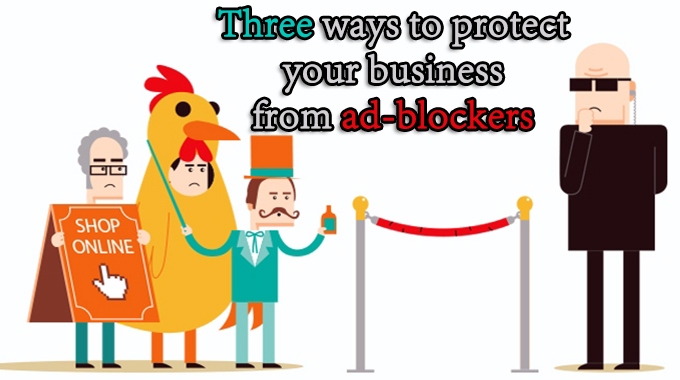Three ways to protect your business from ad-blockers

New guidelines from the Federal Trade Commission have many marketers worried about the future of native advertising.
As is the case with any new regulation, there are some who are opposed to the restrictions. The Interactive Advertising Bureau says it is “concerned” about some of the wording in the new guidelines and has asked the FTC for clarification.
The chief revenue officer of Forbes Media, Mark Howard, is worried the new rules will limit creativity:
“As soon as you start to standardize things and put guidelines around things, you limit the level of creativity and innovation that is able to occur. If you put out stringent guidelines, are you going to put people back in the box?”
Another concern for marketers is the growing use of ad-blocking software by consumers.
According to GlobalWebIndex, 38% of computer users currently use ad-blockers. And just months after Apple started allowing iOS users to block ads, a whopping 30% of US mobile users report using ad-blockers.
Throwing even more fuel onto the fire, there is also concern that as they become more and more sophisticated, more ad blockers could begin to block native ads than those already being reported.
There’s still debate as to the actual financial impact of ad blockers. WPP’s Martin Sorrell contends that there’s been no noticeable effect on advertisers thus far, while Adobe and PageFair claim thatmore than $22 billion in global ad revenues were lost in 2015 due to ad blockers.
At any rate, the increasing popularity of ad blocking software is a very real threat to marketers, whether they’re already feeling the pinch or not. With rates for PPC based on the popularity of the host website, you could be paying top dollar for page views that few will ever see.
It’s time for marketers to shift focus. A smart organic search engine marketing strategy will help make the most of your marketing budget this year.
We’ve identified three of the smartest ways brands can keep their marketing dollars from going down the drain.
Earn your place in prime media outlets
While it can be a tougher nut to crack, “earned media” (through public relations outreach) is a great way to gain visibility across media outlets where your target audiences spend their time.
Identifying ways you can highlight your brand in news features could connect you with prospects and add to the positive listings consumers uncover as they research brands to make informed purchasing decisions.
Work to identify queries and channels your audience is using to connect with your brand presently, and expand your search to identify additional outlets your audience members are actively engaging with where your brand might find a warm reception as a resource.
Earned media coverage may be looked favorably upon by search engines and can help create a diversified channel for leads that are not dependent on ad spend.
Inspect search engine results for third-party placement opportunities
Beyond the scope of earned media, there are rich opportunities to take advantage of with third-party consumer websites like ConsumerAffairs.com or Yelp, where brands can build quality business listings and even showcase customer feedback to build increased consumer trust.
Many third-party review sites already rank highly for coveted root and consumer-focused queries, so using these listings to present a positive and transparent brand experience is one of the most cost-effective ways to climb the ranks and increase SERP (search engine results page) real estate quicker than more traditional SEO efforts.
Brands who invest wisely in quality third-party listings, actively monitoring and engaging with their customers and prospective customers, benefit from being in the best position possible to reach consumers who are using these sites to select the right products and services for their needs.
While an ad may reach the right person at the wrong time, consumers who use review sites are by and large using review websites to actively research before a purchase (70% according to an internal survey conducted by ConsumerAffairs).
Finding prospects who are further along in the sales cycle gives brands the opportunity to convert quickly and reach more highly qualified leads, making marketing spend in this channel incredibly effective.
Keep up with compliance, but always deliver on quality content
If your team is incorporating native campaigns in your marketing efforts, focus on delivering quality content that actually offers consumers a worthwhile, notable experience.
Beyond just a pitch to buy, a great content experience can create a positive association with a brand without a single sales-focused sentence. What does your target audience love that you can deliver through native efforts? Where can you step outside of sales messaging and craft content that shows consumers the voice and spirit of your brand?
Compliance will always be a key part of demonstrating a commitment to ethical business practices toward consumers. While the temptation to use trickier language to present native content is felt by many, brands will ultimately benefit from being transparent about their paid marketing efforts to earn the respect of savvy consumers.
Consumer trust is built on a foundation of customer voices backing up the message your paid advertising sends.
Finding opportunities where a target audience could organically encounter information about or from your brand remains one of the most valuable ways marketers can reach more eyes and avoid connecting with consumers whose ad blocking software has blocked native content efforts.
These three tactics will help build a marketing strategy guaranteed to last as more consumers look to organic search for solutions to their needs.
___
by Danica Jones

